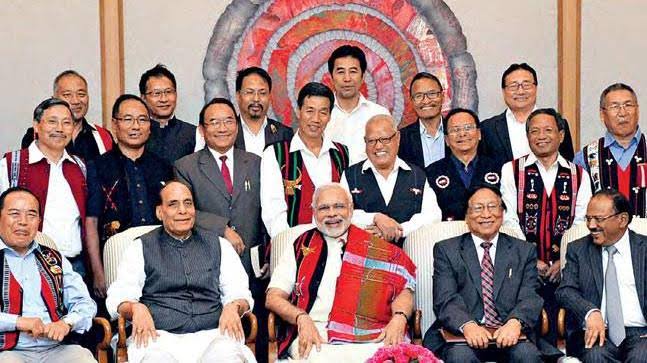
File Picture
The report that the Government of India is keen to reach out to the Naga rebel Groups to put an end to the oldest separatist movement by September this year has naturally caused much excitement in the north east. The visit of the veteran leader T.Muivah of NSCN (I and M), the largest of the rebel Naga Groups to Delhi and the talks the Government of India officials are holding with him and other Naga Groups under the umbrella organization of the militants- Naga National Political Groups (NNPG) did cause hopes for an early resolution of the conflict. However Muivah has thrown a spanner by releasing to the press in mid August the details of the Aug 3 2015 Frame work Agreement for peace the Naga rebel Groups signed with the Government of India and claiming that his core demands of what he called” shared sovereignty, separate Constitution and a flag” were Incorporated in the Agreement that was signed by the official ” interlocutor” RN Ravi, presently Governor of Nagaland . It may be recalled that Ravi has been publicly objecting to the open acts of extortion by the “armed gangs ” in Nagaland and ” running a parallel government” in violation of the 2015 Agreement. It looked as if the Agreement was dead even when Ravi didn’t make any comments on the claims of Muivah. From a larger perspective, the Governor’s action regardless of the other hat he wears as the ” interlocutor” was unexceptionable, steadfast and in the national interest as he brought out how since 1997 cease fire, the very armed groups which signed the cease fire agreement made extortion as their main ” enterprise” by making full use of the “cease fire”.
The demand for a new Interlocutor made by the NSCN (IM) is therefore understandable and merits rejection. Interestingly on August 18 last several Naga civil society Groups such as the broad based Central Naga Tribal Council and Hohos meaning platforms representing Lotha, Zoliangrong and 14 Naga tribes have represented to the Center for continuing Governor’s role as the Interlocutor . This is significant as it shows that the common Nagas are tired of ” insurgency” which has now become a good business for some but misery for other citizens and obstructed peace and development of the state and its people on near permanent basis. The insurgent leaders should see that after abrogation of special status on August 5 last year to Kashmir under Article 370 and 35A which allowed a separate Constitution and a flag, it would not be realistic to expect the Centre to concede the same to the Naga rebels.
In this background the report of the Guwahati based Assam Tribune that to meet the other major demand of the Naga rebel Groups, that is, incorporation of Naga inhabited areas of the adjoining states of Assam , Arunachal and Manipur in Nagaland to constitute Nagalim, meaning greater Nagaland ,the Government of India is examining if such areas could be granted autonomy under the Sixth schedule of the Constitution instead of outright incorporation deserve public attention. This will establish Naga identity meeting thereby the aspirations of the Nagalim and appears to be a practical solution provided the concerned states agree as there could be serious problems especially in Manipur: In Manipur, the Tangkhul Nagas of Ukhrul and other hill areas which form over 80% of the state territory, the Naga groups constitute a “geopolitical minority” meaning that they form the majority in the hills even when they are a minority in the state. Hence the grant of autonomy under the Sixth schedule to the elected Autonomous District Councils in such areas with the powers to make laws, impose taxes ,operate a Budget and a consolidated fund and to receive funds directly from the center make these areas almost at par with the states under the Constitution. Further, the transfer of the wide range of” development” subjects and the power to administer land, forests, water, regulate Trading by non tribals , deliver justice under customary laws would, as experience of Bodoland in Assam suggest, make these bodies very much like a state . Even when the subject of” law and order” is retained by the state as in Assam, the state officials in the Sixth schedule areas have to take the council on board in matters pertaining to the maintenance of public order.
So if the Sixth schedule could provide so much autonomy and scope to preserve the identity of the Nagas in Manipur and Arunachal there is no point in demanding inclusion of these areas into Nagaland. The Naga rebel leadership should remember that the Sixth schedule as first enacted included Naga Hills District in Part A of the table ( no 4) and The Naga Tribal Area in Part B sl.2 along with Frontier Tracts; and that in deference of the demand of the Nagas, the Naga inhabited Tuensang Frontier Division ( Naga Tribal Area under Part B above) was merged into Naga Hills District of Assam to form a new administrative unit – Naga Hills and Tuensang Areas of Assam under the Naga Hills Tuensang Areas Act 1957. It is this integrated area which formed the state of Nagaland under the State of Nagaland Act 1962. In a way that was the first move to Nagalim. The next practical step might as well be the grant of the Sixth schedule status to the Naga inhabited areas of Manipur and Changlang – Dibang valley areas of Arunachal.In Assam areas inhabited by the Naga tribes such as Jemi Nagas are already under the Sixth schedule areas of Dima Hasao and Karbi Anglong .
Statesmanship demands appreciation of the ground reality of what is achievable. It is high time the NSCN ( IM) realized it and accept the offer Centre might be making in the larger interest of the Naga people in India. The Nagas are a scattered tribe as there is a Naga Self Administered territory in the adjacent Myanmar right now. So peace and progress of Indian Nagas will give a push to the progress of the Nagas as a whole. It’s time for Muivah and other groups to act positive and respond to the Prime Minister Modi’s initiative to bring about a peaceful resolution of this conflict and all round progress in Naga inhabited areas.
[the_ad id=’22723′]


















